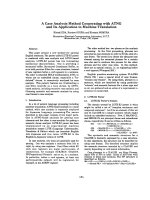65298-Yahoo-Case-Analysis
Bạn đang xem bản rút gọn của tài liệu. Xem và tải ngay bản đầy đủ của tài liệu tại đây (1.3 MB, 54 trang )
Yahoo!
Case
Analysis
May 9
2007
The strategy of implementation of an established dot com company, struggling
to leverage current advertising methods with business objectives.
Jason Drohn
Bradley Bierer
Carol Woods
Michelle Victory
Paul Rapela
2
Table of Contents
Executive Summary ......................................................................................................................... 3
History: ............................................................................................................................................ 5
Problem ........................................................................................................................................... 7
Competitive Analysis ....................................................................................................................... 9
Yahoo Financials ............................................................................................................................ 12
Economics ..................................................................................................................................... 19
Demographics ............................................................................................................................... 23
Market Analysis ............................................................................................................................. 30
CPM ............................................................................................................................................... 34
SWOT MATRIX: .............................................................................................................................. 36
QSPM............................................................................................................................................. 38
Space Matrix ................................................................................................................................. 39
Strategic Issues.............................................................................................................................. 42
Strategy Implementation .............................................................................................................. 47
3
Executive Summary
Yahoo has grown up as a portal company. They learned early on that by being sticky, by
having a web presence that forced users to stay on their site, they could find ways to profit
from the page views. This has led Yahoo astray though. Not only has Yahoo given up overall
profits in search of ever expanding user acquisition, they have allowed their search product to
fall behind.
Google, Yahoo’s chief competitor, has mastered the art of monetization, namely
through contextual advertising. Contextual advertising is when a small piece of programming
code is inserted into web pages which actually interprets the text and serves advertising based
on keywords. Google’s offering, Adsense and Adwords, produces 99% of the company’s profits.
This advertising network is built into both their search and branded sites. Web publishers are
also growing to adopt Google’s version of website advertising to gain monetization for their
own traffic.
Yahoo has adopted this model of contextual advertising that has been so profitable for
Google, but have yet to refine it enough to make a serious impact on the market. The program
is still in beta (the internet’s way of saying under-construction) and has not made any headway
at attracting new publishers or advertisers.
The primary disconnect in the Yahoo model has been the lack of precision, because their
search algorithm needs to be updated. The ad network fails to interpret that an article is
written about cars, and serves ads about entrepreneurs. Money is only made if a user clicks on
the advertisements. This is an interesting dilemma.
4
On the positive side, Yahoo has a brilliant banner serving system. Since Yahoo still sees
itself as a portal, it still leverages Yahoo Money, Cars, Email, etc. Each of those sites has
products or services that provide value to the user. A user shopping for cars is later targeted
with banner ads reflecting the cars that they were viewing online.
In our estimation, Yahoo needs to focus on core content by improving exactly what it is
that makes them money. They should focus on improving their ad network’s efficiency and
allowing all publishers admittance. They should leverage their banner serving software with
the contextual market and provide growth that way.
Google, the market leader, is simple and built around search. Yahoo needs adopt a like
philosophy to remain competitive in their market.
5
History:
Yahoo! Incorporated is an Internet service provider that serves both users and business
globally. The company was founded in 1994 by David Filo and Jerry Yang who were attending
Stanford University’s PhD program (The History of Yahoo!). Yahoo! Inc. began as a hobby for
Filo and Yang and has now evolved into a multifaceted brand that serves internet users
worldwide (The History of Yahoo!). Yahoo! Inc. has become the world’s largest global online
network of integrated services (The History of Yahoo!). According to the Yahoo! Inc. website,
they have become one of the leading search engines on the World Wide Web (The History of
Yahoo!).
Yahoo! Currently has 500 million users worldwide that visit the site each month. Yahoo!
is provided to users in more than twenty different languages (Yahoo! Inc). The company also
has office locations in Europe, the Asia Pacific, Latin America, Canada and the United States
(Yahoo! Inc). Yahoo! Inc. is currently headquartered in Sunnyvale, California (Yahoo Inc).
Yahoo! Inc. was incorporated in California in March of 1995 (Yahoo! Inc). Yahoo! Inc.
first went public on NASDAQ in April of 1996. At this time Yahoo!’s stock opened for $13.00 per
share (Yahoo! Inc.). At the close of its first day of the IPO, Yahoo! stock had reached a closing
price of $33.00 per share (Yahoo! Inc). At this time the company only had 49 employees
(Yahoo! Inc). The company was then reincorporated in Delaware in May of 1999 (Yahoo! Inc).
In December of 1999 Yahoo! Stock was added to the S&P 500 (Yahoo! Inc).
In 1996, Yahoo! Inc. began entering into joint ventures with SOFTBANK (Joint Ventures).
Through this initial joint venture, Yahoo! Inc. was able to create Yahoo! Japan. Subsequently
6
Yahoo! Inc. has teamed with SOFTBANK to create markets in Germany, United Kingdom,
France, and Korea (Joint Ventures). Yahoo! Inc. and SOFTBANK have also created GeoCities
Japan Corporation to create and manage a Japanese version of the GeoCities website (Joint
Ventures).
Yahoo! Inc. has also teamed in a joint venture with VISA to establish Yahoo!
Marketplace (Joint Ventures). This joint venture occurred in August of 1996 and has since then
created a navigational service focused on information and resources for the purchase of
consumer products and services over the internet (Joint Ventures). This joint venture alone
created a new market for Yahoo! Inc (Joint Ventures).
Most recently, in January 2006, Yahoo! Inc. and Seven Network Limited , also known as
SEVEN, have teamed in a joint venture as well (Joint Ventures). SEVEN, an Australian media
firm, signed an agreement with Yahoo! Inc (Joint Ventures). In this agreement, Yahoo! Inc
(Joint Ventures). contributed its Australian internet business, Yahoo! Australia and New
Zealand, and SEVEN contributed its online assets, television and magazine content (Joint
Ventures). Yahoo! Inc. has a fifty percent equity ownership in the joint venture which will
operate under the name Yahoo7 (Joint Ventures).
Yahoo! Inc. also operates Flickr, a photo sharing and storing website (Yahoo! Inc profile).
The company also provides its users with web mail, instant messaging, music, video, personals,
and much more (Yahoo! Inc profile).
7
Problem
Yahoo is a master of portals, but they have let their search product suffer. They have
long built out their offering in such a way to add value to their users through functionality while
they hoped that revenue would be made in the process. There was no clear attempt to either
target those users with advertising or extend any real value added services.
This portal terminology has run so deep that it is engrained in the Yahoo culture. Search
is a product of users making their way through the Internet, rather than the core of their
business. Yahoo sees their core business as being Yahoo News, Finance and Mail. They have
made acquisitions such as MyBlogLog and Flickr. For what though? To extend functionality or
to increase revenue.
The all inclusive Yahoo is counting on the traffic to be monetized through private
advertising deals and partnerships. Partners usually pay to have their service included in the
Yahoo Directory in one form or another. These joint partnerships are encouraged because it
not only brings Yahoo recurring revenue, but allows the partner a strategic place in the Yahoo
network. The partnering service typically sees a boost in traffic, thanks to being networked
with such a big web presence.
Private advertising comprises the other side of the revenue deal. Private advertising is
such that a company may put their banner in a prominent location of the Yahoo network.
Similar to partnerships, the private sponsors are limited to the banner placements that are
bought. For example, Newegg.com, a well known computer retailer, might put a banner ad on
8
the Yahoo home page for $50,000 a month. This banner ad is then targeted to each and every
user who enters the Yahoo home page.
The problem is that web publishers, those that own their own websites are not able to
capitalize on this revenue model. Yahoo promotions are concentrated to being served on
Yahoo’s pages. Publisher’s do not have a chance to leverage Yahoo’s size and revenue potential
the way that Google has empowered their users, through the contextual ad system.
Yahoo is the most trafficked website on the planet. More pageviews are served from
Yahoo servers than any other company in the world. Why is it that they are trailing Google in
revenue then? Because Google allows other publisher’s to maximize the ad network. 82% of
Google’s revenue is achieved not on their site, but on other web publishers.
9
Competitive Analysis
As taken from the Yahoo 10K, “We primarily compete with companies to attract users to
our website and advertisers to our marketing services. We expect the market to become
increasingly competitive if online marketing continues to grow and gain acceptance on a global
basis.”
Yahoo’s primary
competitors are Google,
AOL, and MSN. All of
which compete in the
industry of “Internet
Information Providers.”
However, because AOL is
held as a limited liability
corporation and MSN is a
division of Microsoft,
data is not readily
available for either section. This critique will have elements from both companies, including
information taken from Microsoft’s 10K report and AOL’s few public records.
The first key difference to note is the fact that each company differs in its primary
company beliefs. Yahoo sees itself as a portal “to connect people to their passions, their
communities, and the world’s knowledge (Yahoo 10K).” Google’s maintains the largest, most
10
comprehensive index of web sites and other content, and makes this information freely
available to anyone with an internet connection. Their automated search technology helps
people obtain nearly instant access to relevant information from our vast online index (Google
10K).” Microsoft’s offering, MSN, “provides personal communications services, such as email
and instant messaging, and online information offerings such as MSN Search, MapPoint, and
the MSN portals and channels around the world (Microsoft 10K).” AOL is simply an internet
service provider who combines the leverage of the Internet with its own branded services.
Although each of these competitors has aligned themselves in the same sector
investment wise and serve the same relative target markets, they define their services
differently. In some sense, this demonstrates how they align their business model as well.
Google lives by its advertiser network, also known as the Google Network, comprised of
Adwords and Adsense. The combination of the two services provides Google with 99% of their
revenue. The revenue may be further divided between 18% on site advertisement and 81% off
site advertisement. Adwords is an online application that allows businesses to publish their ads
to the many websites that participate in the Google Network. Adsense is the destination for
web publishers and site owners who have space on their website for ads. The webmasters
make money every time a Google ad is clicked. Google is essentially the middleman.
Yahoo takes a different alternative to the system. Being the most trafficked website on
the planet, Yahoo sells ads for its own network of sites. But as the 10K notes, Yahoo sees itself
as a gathering place for people to connect with their passions. Yahoo’s specialty ‘pre-Google’
has been monetizing its own web pages.
11
Yahoo’s ad network has proven effective on the front of intelligent ad serving. The
algorithm is built in such a way that it can see where a visitor is going online, within the Yahoo
network, and serves ads based on those tendencies. For instance, if you are looking at a car in
Yahoo Autos and travel to Yahoo Money, you will see a car advertisement. This data is stored
for an indefinite amount of time, so in three months a random car ad may show up again.
Yahoo has only just recently launched an Adwords and Adsense competitor though.
Yahoo’s service is named Yahoo Publisher Network. Yahoo Publisher Network allows the same
functionality that the Google Network does, but is currently in beta. The company has yet to
solidify its stance in the market concerning the advertising software.
As Yahoo states in their 10K, “The principal competitive factors relating to attracting and
retaining users include the quality and relevance of our search results, and the usefulness,
accessibility, integration and personalization of the online services that we offer as well as the
overall user experience on our website. In the case of attracting advertisers, the principal
competitive factors are the reach, effectiveness and efficiency of our marketing services as well
as the creativity of the marketing solutions that we offer.”
They also add, “We believe that we are effectively competing in the Internet services
market as we continue to refine our search technology, build onto our existing online
properties and services, and further improve our users’ experience.”
From this, one may conclude that Yahoo services play a key role in attracting and
retaining users. Whereas, Google has recognized that search is their primary objective.
12
Yahoo Financials
Yahoo trades on the NasdaqGS under the symbol, “YHOO.” For slight comparisons, to
show where Yahoo needs to be, we are going to compare several key statistics with Google’s
results.
With a 52 week range of 22.65 to 28.86 and a volume of 21,102,256; the stock itself is
well traded. The current P/E of 55.57 seems high, especially when compared to the much more
profitable Google; which has a P/E of 48.18.
Here is a snapshot of the top level financials for Yahoo at the time of writing:
Across the top level, revenue has been strong as well since 2002. 2006 revenues come in at
6,425.7 (in millions). Looking at the company snapshot:
13
However, in terms of Google, Yahoo’s chief competitor, there is a discrepancy. Google grew
revenues to 10,604.9 (in millions) since the time of IPO offering in 2003. There revenue is as
follows:
Key Ratios:
Profitability – Upon further examination of Yahoo, the key ratios include:
14
Cost of goods sold has increased as one might expect, throughout the ten year span of
public trading. This is largely due to the increase of server space and supplemental acquisitions
the company has made. These acquisitions include services like Flickr and MyBlogLog.
Research and development is sitting at 13% in 2006, which is higher than Google’s
(which comes in at 11.6%). This is a positive mark for Yahoo.
The EBT, or earnings before tax, as dropped to 17.1% - from 48.4%. This is a cause for
concern. Google’s stands at 34.9 to 37.8 for the last two years.
In dropping to the profitability section, Yahoo’s tax rate is 41.7%, up from 30.2%. This is
not the highest it’s been, though. In 2000 it was 72.7%. Google sits at 23.3%.
Perhaps the biggest discrepancy I can see is that Yahoo’s return on assets dropped from
18.95% in 2005 to 6.73% in 2006. Google remains strong at 21.41%.
Yahoo Growth rates are the most alarming section in this analysis though.
Growth Rates-
Yahoo’s growth rates are as follows:
As pictured above, Yahoo had amazing growth in the late 90’s and in 2003 and 2004.
However, Google was has stormed on the scene, taking the search and advertising market that
previously served with banner ads. You can see this reflected in Yahoo’s falling numbers.
15
Google introduced pay per click services which are the bread and butter of the new search
giant.
Google’s growth:
Google, having their initial IPO in 2004 has grown exponentially. 2004 was a big year for
internet adoption, and the first year Yahoo had a true competitor. Since then Yahoo has fallen
to 47.1% growth and 22.2% growth in 2005 and 2006, respectively. Even in the last quarter,
Google posted a 67% increase, while Yahoo sank to a 13.4% increase.
Cash Flow-
Yahoo’s Cash Flow:
Yahoo’s operating cash flow was down last year, -19.9%, and their free cash flow growth
year over year was down -47.6%. This could be because of several high priced acquisitions.
16
Google’s Cash Flow:
Google didn’t have a stellar year, in regards to cash flow and in comparison to their last
couple, but they still remained in the positive, sitting at 45.6%. That number may have been
reduced because of the YouTube acquisition.
Financial Health-
Yahoo’s financial health is a point of concern, because their cash and short-term
investments have been decreasing year after year. Accounts receivable inventory has remained
constant, and their current assets has been around 2% for the last five years.
In regards to total current assets the company has noticed a drop year over year in Total
Current Assets, landing at 32.6% in 2006. Intangibles and Long Term Assets are at 29.3%
though. I would imagine these stem largely from their offices and datacenters spread around
the world.
The largest concerning factor in this financial analysis is the debt of Yahoo, as compared
with Google. Yahoo has .9% Accounts Payable, but 9.1% of Accrued Liabilities and 2.8& Short
Term Liabilities. Their Long Term debt is at 6.5% which they just picked up in the last 4 years.
Altogether, Yahoo’s liabilities total is 20.4%, leaving the stockholder’s equity at 79.6%
This might seem like an advantage to some, because they are leveraging debt to magnify
earnings, but if you continue further down, the current ratio is 2.54 and the quick ratio is 2.4.
The company isn’t going bankrupt, but has been trending down badly in the last four years.
Google on the other hand demonstrates only 7.8% liabilities, allowing the other 92.2%
to be owned by the stockholders. They have a Current ratio of 10 and a quick ration of 9.63.
The following two pages offer printouts of the full financial statistics.
17
Yahoo’s Financial Health:
18
Google Financial Health:
19
Economics
Economics is defined as, “the social science that deals with the production, distribution,
and consumption of goods and services and with the theory and management of economies or
economic systems.” There are many factors and indexes that are tracked to gauge the health of
the economy. These include gross domestic product, consumer price index, and strength of the
dollar, interest rates, and disposable income.
Yahoo, Inc. relies heavily on accurate information pertaining to all these factors
associated within our economy. Not just what the consumer is spending, more importantly how
the economy is doing as a whole. Yahoo’s expenditures by advertisers tend to be cyclical,
reflecting overall economic conditions and budgeting and buying patterns. Since Yahoo derives
most of their revenues from advertising, any decreases in or delays in advertising spending due
to economic conditions could reduce their revenues or negatively impact their ability to grow
their revenues. Yahoo relies on the value of their brand and a failure to maintain or enhance
the company brands in a cost-effective manner could harm their operating results. (10K) Yahoo
believes that maintaining and enhancing their brand, specifically those that contain the Yahoo
name as well as those that do nothing, is an important aspect of their efforts to attract and
expand their user and advertiser base.
Yahoo has spent considerable money and resources to date on the establishment and
maintenance of their brands in which they anticipate spending increasing amounts of money
on, and to devote much greater resources strictly towards advertising, marketing and other
brand-building efforts to preserve and most importantly enhance the consumer awareness of
20
their brands. The success of Yahoo is depended upon us, the consumers and much money we
are willing to spend on the Internet.
Spending and the availability of monies is not just a major concern with Yahoo, it is with
all other Internet Service Providers. The fear is the increase of CPI indexes and the possibility of
inflation. The consumer price index (CPI) is a tool used to gauge the economy. The CPI is most
commonly used to measure inflation, and businesses use it as a guide in making economic
decisions The CPI is an index of prices used to measure the change in the cost of basic goods
and services in comparison with a fixed base period.(American heritage dictionary) The CPI
includes all goods and services purchased by urban households. The prices that are used to
calculate the CPI are taken from 87 urban areas throughout the country.
The CPI is computed as a percentage of the cost of certain products as compared to a
base year. (The American Heritage® Dictionary) The current base year is 1982-84, which equals
100 percent. Any number above 100 indicates that prices for that year are higher than in the
base year. The most current CPI statistics from the Bureau of Labor Statistics (BLS) are for
February 2007. During February 2007, the CPI rose by .5 percent to a level of 203.499. This
figure means that consumer prices for February 2007 were 103.499 percent higher than in the
base year. This was an increase of 2.4 percent since February 2006. The CPI is divided into
several different sections. Sections include housing, food and beverage, transportation, and
energy. The index for food and beverage increased .8, housing .4, transportation .1, and energy
.9 during the same time period.
21
When consumer prices rise, everything else seems to follow. The increases will affect
Yahoo’s business relationships with the third-party content providers, which will become
critical to their success. As competition for compelling content increases the prices at which
they offer their content to them and potential content providers may not offer their content to
Yahoo on terms that can be agreeable to them. An increase in prices charged by the third
parties to them could harm their operating and financial condition. Further, many of Yahoo’s
content licenses with the third parties are non-exclusive. Accordingly, other webcasters and
other media such as radio or television may be able to offer similar or identical content. This
increases the importance of their ability to deliver compelling editorial content and
personalization of this content for users in order to differentiate Yahoo from Google and MSN.
If Yahoo is unable to license or acquire compelling content at reasonable prices, if Google, or
MSN broadcast content that is similar to or the same as that provided by Yahoo, or if they do
not develop compelling editorial content or personalization services, the number of users of
their services may not grow as anticipated, or may decline which could harm their operating
and financial results. (10K)
Interest rate changes will affect the operating expenses of Yahoo, their third- party
affiliates’ and their competitors. Interest rates are controlled by the policy makers of the
Federal Reserve Board.(FED) The rates established by the FED are used by banks and lending
institutions to set the interest rates for loans and credit cards. By manipulating the federal
funds rate, the FED tries to control inflation and keep the economy strong while preventing a
recession. The FED sets this rate at a level to keep the financial and monetary conditions of the
22
economy in line and adjusts the rate for changing economic conditions. A change in these rates
by the FED, or the expectation of a change, can trigger changes to the short term and long term
interest rates, the foreign exchange value of the dollar, and stock prices. Changes in these rates
affect the spending decisions of both households and businesses.(federalreserve.gov)
The FED raises the federal funds rate to slow down economic growth and curb inflation.
They lower the rate to stimulate a sluggish economy and encourage growth. Since June 2006
the federal funds rate has been stable at 5.25 percent. During the prior two years, the FED has
raised the federal fund rate 17 times. Should we be concerned? Should Yahoo, Google and
others be concerned? Yes, as noted earlier when the cost of items increases so will others soon
to follow. The increase in interest rates will affect the anticipation of Yahoo’s much needed
expansion into the world of cyberspace.
23
Demographics
Internet World Stats (2007) reports as recently as March 10, 2007, Yahoo! has a
potential global customer base of 1,114,272,426 people who access the Internet. The usage
growth period charted is for the years 2000-2007. Of the data presented Asia, Europe, and the
Untied States are the three top users of the Internet globally. Africa, Asia, Middle East, and
Latin America/Caribbean reflect the largest usage growth while North America reflects the
lowest growth percentage rate globally in the charted period.
WORLD INTERNET USAGE AND POPULATION STATISTICS
World Regions
Population
( 2007 Est.)
Population
% of
World
Internet
Usage,
Latest Data
%
Population
(
Penetration
)
Usage
% of
World
Usage
Growth
2000-
2007
Africa
933,448,292 14.2 % 33,334,800 3.6 % 3.0 %
638.4%
%
Asia
3,712,527,624 56.5 % 398,709,065 10.7 %
35.8
%
248.8%
%
Europe
809,624,686 12.3 % 314,792,225 38.9 % 28.3%
199.5
%
Middle East
193,452,727 2.9 % 19,424,700 10.0 % 1.7 %
491.4
%
North America
334,538,018 5.1 % 233,188,086 69.7 % 20.9%
115.7
%
Latin
America/Caribbean
556,606,627 8.5 % 96,386,009 17.3 % 8.7 %
433.4
%
Oceania / Australia
34,468,443 0.5 % 18,439,541 53.5 % 1.7 %
142.0
%
WORLD TOTAL 6,574,666,417 100.0 % 1,114,274,426 16.9 %
100.0
%
208.7
%
NOTES: (1) Internet Usage and World Population Statistics were updated on Mar. 10,
2007. (2) CLICK on each world region for detailed regional information. (3)
24
Demographic (Population) numbers are based on data contained in the world-gazetteer
website. (4) Internet usage information comes from data published by Nielsen//NetRatings, by
the International Telecommunications Union, by local NICs, and other other reliable sources. (5) For
definitions, disclaimer, and navigation help, see the Site Surfing Guide. (6) Information from
this site may be cited, giving due credit and establishing an active link back to
www.internetworldstats.com. Copyright © 2007, Miniwatts Marketing Group. All rights reserved
worldwide.
Internet World Stats (2007) illustrates that North America had the lowest usage growth
rate by world region, but does reflect the highest Internet global penetration.
25
Internet World Stats (2007) presents the following pie chart of the world Internet user.
The World Bank Group (2007) charts internet user data. The user data can be
disaggregated into many forms of information such as: gender, age, frequency, and household
income. The available information on the use of the Internet globally is inadequate in scope
due to the limited number of countries which collect information and communication
technology making it difficult to ascertain the market for global Internet industry (pg. 1).
The United States provides the most information on the use of the Internet in the North
American Region. The following World Band Group graph was last updated January 11, 2007.
Demographics of Internet Users
Below is the percentage of each group who use the internet, according to our
December 2006 survey. As an example, 69% of adult women use the internet.
Use the internet
Total Adults 70%
Women 69









